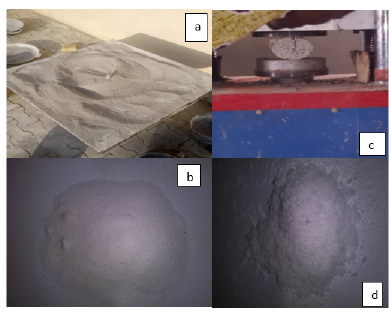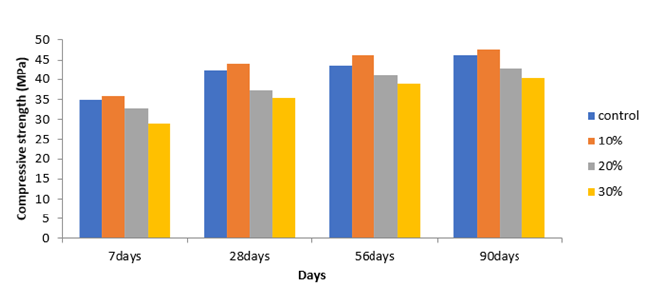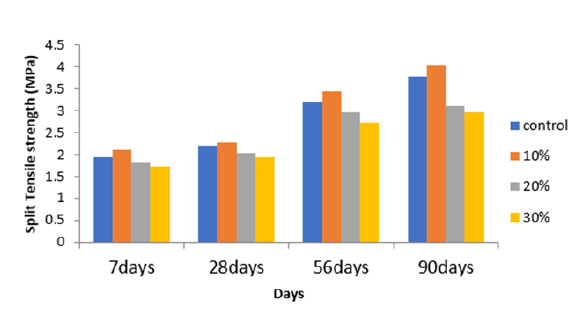- Submissions

Full Text
Research & Development in Material Science
Assessment of Mechanical Strength of Eco-friendly Slag-Concrete and Metakaolin in an Aggressive Environment
Abiola OS*, Igba UT, Odunfa SO, Adetiloye A, Gbadewole OA and Osinowo AA
Department of Civil Engineering, Federal University of Agriculture, Abeokuta, Nigeria
*Corresponding author: Abiola OS, Department of Civil Engineering, Federal University of Agriculture, Abeokuta, Nigeria
Submission: June 14, 2022;Published: June 27, 2022

ISSN: 2576-8840 Volume 17 Issue 2
Abstract
This paper presents an assessment of mechanical strength of slag-concrete with partially replacing cement with 0, 10, 20, and 30% metakaolin (MK) for a targeted strength of 35MPa at 28-day curing. The compressive, split tensile and flexural strength of the concrete were examined in line with appropriate specifications. The durability was evaluated by exposing the concrete specimens to sodium sulphate and sodium chloride for 7, 28, 56, and 90 days and measure the loss in compressive strength. The mix design with water-cement ratio of 0.5 is 1:1.21:2.89 (cement: sand: coarse slag). The targeted compressive strength was met by all the percentages of metakaolin though the strength decreases with increase in percentage of metakaolin added. The MK10 has the highest value for compressive, split tensile and flexural strength above the control. The slag-concrete showed more resistance to sulphate attack and exposure to chloride than the control. The maximum loss was obtained at MK30 (10.77%) for 28-days and the minimum loss was 5.87% at 90-days. Loss in compressive strength for concrete cured in sodium chloride showed less deterioration compared to sulphate cured concrete. Based on the obtained results 10% of metakaolin and 100% steel sag will produce eco-friendly concrete pavement and preserve the natural resources.
Introduction
Waste generation has increased greatly as a result of urbanization causing a great problem of disposing them. This has led to various studies to explore every possible way of reusing the wide range of waste materials. Concrete consumes quite a large amount of natural raw aggregates, which cannot be sustained without the use of alternative cheap materials which can be sourced locally [1,2]. Eco-friendly concrete reduces the greenhouse gas emissions, preservation of natural resources and promotes the use of waste materials in concrete [3-6].
Steel slag which is a by-product of scraps of iron and steel, about 96 to 145 million metric tons of steel slag are produced yearly in Nigeria [7]. They are disposed indiscriminately around the manufacturing areas thereby constituting environmental hazards [1]. The characteristics of steel slag depends on the manufacturing process and the main oxides are calcium, silicon, iron and other oxides such as aluminum, magnesium and manganese. The oxides of calcium and magnesium in steel slag aggregate has been found to affect concrete negatively causing volume expansion as a result of hydration with water [8-10]. Studies have shown that a common solution to the expansion issue is to stockpile for six months or use within 90 days of continuous watering within this period [11,12]. Generally, steel slag is denser and has higher water absorption properties than natural aggregates, this can influence the concrete’s absorption properties [13,14]. Researchers have reported the use of steel slag in concrete with improved mechanical strength characteristics such as compressive, tensile, flexural and abrasion resistance [1,15,16]. Since the performance and studies of steel slag in concrete is an on-going and location specific, this study aims at using 100% steel slag as coarse aggregate with partial replacement of cement with metakaolin in concrete pavement. Concrete durability is important since it must resist in various aggressive environment.
Metakaolin (MK) has been regarded as a good supplementary cementitious material and environmental friendly [5,17,18]. Metakaolin is not an industrial by-product but generated by calcination of kaolin clay at temperature of 6500 and 800 0C. It is used to improve the workability, strength, resistance to cracks as well as durability of concrete [5,19]. Dinakar et al. [20] reported a compressive strength of 106MPa was obtained with 10%MK replacement moreover, MK concretes showed a good resistance compared to control in terms of durability test. In their research [5] MK was replaced at 10, 20, 30 and 40% in the production of concrete with recycled concrete aggregates at a targeted strength of 45MPa at 28-day test. The durability and targeted compressive strength were achieved at 20% MK replacement. This study aims at assessing the mechanical characteristics of steel slag concrete and partial replacement of cement with metakaolin in an aggressive environment.
Materials and Methods
Materials
The metakaolin was obtained after calcination of kaolin at 650 ℃ for 90 minutes and its chemical composition was determined (Table 1). Coarse aggregate of 100% steel slag of average size of 19mm obtained from industrial company in Shagamu Ogun State which has been stockpile for over one year, specific gravity, loose and compacted bulk density was examined while sharp sand was used as fine aggregate. Portland limestone cement of grade 42.5N was obtained from open market.
Table 1: Chemical composition of metakaolin and steel slag.

Cement was replaced with MK at 0, 10, 20, and 30% by weight with water-cement ratio of 0.5 and targeted strength of 35MPa at 28 days. Water reducing admixture at 1% was added to improve the workability of the concrete.
Mix design and methods
The mix design was done using ACI 211 4R-08 [21] and are cement, fine aggregate and coarse steel slag in proportion of 1:1.21:2.89 respectively (Table 2). The moulds of 100 x 100 x 100mm, 100mm diameter x 200 mm height cylinder and 100 x 100 x 500mm were used for compressive strength (BS EN 12390- 3, 2009 [22]) , split tensile strength (BS EN 12390-6, 2009 [23]), and flexural strength (BS EN 12390-5, 2009 [24]) respectively. They were lubricated, filled with fresh concrete in layers and the specimens were kept under cool environment for 24 hours before demoulding (ASTM C 192 [25]). Three specimens were made for each mix and cured fully submerged in water tank for 7, 28, 56 and 90 days before testing.
Table 2: Mix design.

Durability test was carried out through curing the concrete specimens in 5% 0.1M sodium sulphate and 5% 0.2M sodium chloride solutions (Figure 1) for 7, 28, 56 and 90 days. The solutions were replaced at regular intervals to maintain constant concentration. Loss in compressive strength was assessed.
Figure 1:a-metakaolin; b-sodium sulphate; c-split tensile test; d-sodium chloride.

Results and Discussion
The results of test on MK showed that the specific gravity is 3.0, loose and compacted bulk density are 1452.8 and 1603.77kg/ m3, the specific gravity and fineness modulus of river sand is 2.57 and 3.44 respectively. The results of X-ray diffraction of steel slag presented in Table 1 showed that magnesium oxide which is responsible for concrete volume expansion is not presented and could have been to the fact that the slag has been stockpile for a long time. The addition of the three major oxides amount to 67.99% for steel slag and 97.49% for MK. The higher content of iron oxide in the slag could be attributed to the source and composition of the scrap used.
Mechanical strength characteristics
Figures 2-4 shows the results of the compressive, split tensile and flexural strength obtained from the concrete mixes at 0, 10, 20 and 30% replacement with MK. The compressive strength for all the specimens increased with age, the targeted strength (35MPa) was satisfied by all the percentages of MK considered. Generally, for the curing days, the compressive strength decreases as the percentage of MK increases. It was also observed that 10% MK has higher compressive strength than that of the control for all the ages, the increase was 2.53, 4.10, 5.95 and 2.86% for 7, 28, 56 and 90 days of curing respectively. The result obtained is in agreement with [20] which also obtained the optimum replacement level of cement by MK at 10% that gave the highest compressive strength. The result clearly shows that 10% MK is the optimum in respect of compressive strength.
Figure 2: Compressive strength and curing days.

Figure 3:Split tensile strength and curing days.

The average value of the split tensile strength for 28 days as shown in Figure 3 for control and MK 10 was about 2.21 and 2.28MPa respectively. This corresponds to 5.20 and 5.12% of the compressive strength for the control and MK10. It can be observed that the split tensile strength also was the highest at MK 10 [20]. The result indicate that increase over the control for 7, 28, 56 and 90 days are 8.25, 3.17, 7.48 and 7.16%.
The results of flexural strength as shown in Figure 4 also indicate that the values are higher at MK10 for all the curing days compared with control specimen. The value (11.01MPa) obtained at 7 days is more than what was recommended by AASHTO (4.5-6.0MPa) for concrete pavement. It can be concluded that the flexural strength of Slag-concrete increased with the increase in percentage of MK.
Figure 4:Flexural strength and curing days.

Durability characteristics of MK-steel slag concrete
The compressive strength was examined after 7, 28, 56 and 90 days of immersion in sulphate and chloride solution. The specimens were compared with the compressive strength cured in water and the results of the loss are presented in Table 3 & 4 respectively.
Table 4: Percentage loss in compressive strength (Sulphate Solution).

Table 5: Percentage loss in compressive strength (Chloride Solution).

The result of compressive strength loss for sulphate attack specimens shows more loss for the control than for all the specimens with MK. The strength for the control was 8.55% and that of MK 10 was 6.92%. The loss reduces from the 7th day to the 28th and afterwards increases which was also reported by [26], the maximum loss for the MK30 replacement was 10.77% at 28 days. The minimum loss was 5.87% with MK10 at 90 days. The result obtained clearly allude to the fact that metakaolin can improve sulphate resistance in concrete [27,28].
The loss in compressive strength of the MK-steel slag concrete exposed to sodium hydroxide is shown in Table 4. The rate of deterioration in sodium chloride is less severe when compared with sulphate attack resulted in the formation of ettringite, which makes it more detrimental than chloride attack. The control specimen decreased by 7.59% and MK10 decreased in strength by 3.22% at 90 days of immersion in sodium chloride. The loss in strength decreases as the percentage of MK increases.
Conclusion
This study presents the results of mechanical strength of an
eco-friendly slag-concrete with partial replacement of cement with
0, 10, 20, and 30% metakaolin in an aggressive environment. The
following detailed conclusion can be drawn:
1. The targeted strength of 35 MPa at 28 days >of curing has the
ratio of cement, fine and coarse aggregates as 1:1.21:2.89.
2. The 35 MPa was met by all the percentages of metakaolin. The
compressive strength decreases with increasing in percentage
of metakaolin
3. The MK10 has the highest compressive strength, tensile
strength and flexural strength above the control
4. The split tensile strength at MK10 over the control increase in
8.25, 3.17, 7.48, and 7.16% at 7, 28, 56 and 90 days respectively
5. The flexural strength of Slag-concrete increased with the
increase in percentage of MK.
6. The durability shows that loss of compressive strength was
more with the control specimen than MK specimen. The
maximum loss was 10.77% for MK30 at 28 days while the
minimum loss was 5.78% for MK10 at 90 days.
7. Loss in compressive strength for concrete cured in sodium
chloride showed less deterioration compared to sulphate
cured concrete.
8. Based on the obtained results 10% of metakaolin and 100%
steel sag will produce eco-friendly concrete pavement and
preserve the natural resources.
References
- Olonade KA, Kadiri MB, Aderemi PO (2015) Performance of steel slag as fine aggregate in structural concrete. Faculty of Engineering, University of Nigeria, Nigeria, 34: 452-458.
- Winfield M, Taylor A (2005) Re-balancing the load: the need for an aggregate’s conservation strategy for Ontario. The Pembina Institute, pp. 8-9.
- Igba UT (2020) The use of rice husk ash in production of green concrete. Proceedings of 18th International Conf of Nigerian institution of Civil Engineers.
- Suhendro B (2014) Towards green concrete for better sustainable environment. Procedia Engineering 95, Proceedings of the 2nd Conf. on Sustainable Civil Engineering Structures and Construction Materials, pp. 305-320.
- Abiola OS, Suilamon BA, Odunfa SO (2018) Durability properties of concrete made with recycled concrete aggregate and metakaolin as cement replacement. Academic J Sci Eng 12: 57-71.
- Abiola OS (2021) Performance evaluation of polypropylene granules: A partial replacement for sand in a steel slag concrete block pavement. Scientific African, Vol. 14.
- Akinwumi I, Adeyeri J, Ejohwomu OA (2012) Effects of steel slag addition on the plasticity, strength and permeability of lateritic soil. ICSDEC, pp. 457-464.
- Abu-Eishah SI, El-Dieb AS, Bedir MS (2012) Performance of concrete mixtures made with Electric Arc Furnance (EAF) steel slag aggregate produced in the Arabian gulf region. Constr Build Mater 34: 249-256.
- Pang B, Zhou Z, Xu H (2015) Utilization of carbonated and granulated steel slag aggregate in concrete. Constr Build Mater 84: 454-467.
- Kolawole JT (2020) Performance of concrete containing Nigerian electric arc furnace steel slag aggregate towars sustainable production. Sustainable Materials and Technologies 25: e00174.
- FHWA (2008) User guidelines for waste and byproduct materials in pavement construction. Federal Highway Administration, USA.
- Fronek B (2012) Feasibility of expanding the use of steel slag as a concrete pavement aggregate. : Cleveland State University, Cleveland, Ohio, USA.
- Rondi L (2016) Concrete with EAF steel slag as aggregate: a comprehensive technical and environmental characterisation. Compos Part B Eng 90: 195-202.
- Adegoloye G (2015) Concretes made of EAF slag and AOD slag aggregates from stainless steel process: mechanical properties and durability. Constr Build Mater 76: 313-321.
- Jiang Y (2018) Characteristics of steel slags and their use in cement and concrete - a review. Resources, Conservation and Recycling 136: 187-197.
- Yuksel O (2017) A review of steel slag usage in construction industry for sustainable development. Environment, Development and Sustainability 19: 369-384.
- Shekarchi M (2010) Transport properties in metakaolin blended concrete. Constr Build Mater 24: 22177-2223.
- Poon CS (2001) Rate of pozzolanic reaction of metakaolin in high performance cement pastes. Cem Concr Res 31(9): 130-1306.
- Monadiri Abdelilah (2022) Evaluation of the durability of concrete associated with flash metakaolin or silica fume. Materials Today: Proceedings 58: 1549-1556.
- Dinakar P, Sahoo PK, Sriram G (2013) Effect of metakaolin content on the properties of high strength concrete. International Journal of Concrete Structures and Materials 7: 215-223.
- ACI (2009) Standard practice for selecting proportions for normal, heavyweight and mass concrete. American Concrete Institute, Farmington Hills, USA.
- BS EN (2009) Testing hardened concrete: Compressive strength test of specimens. British Standards Institution, London, UK.
- BS EN (2009) Testing hardened concrete: Tensile spliting strength test specimens. British Standards Institution, London, UK.
- BS EN (2009) Testing hardened concrete: Flexural strength test specimens. British Standards Institution, London, UK.
- ASTM C (2019) Standard practice for making and curing concrete test specimen in the laboratory. American Society for Testing Materials International, West Conshohocken, USA.
- Thomas BS (2015) Performance of high strength rubberized concrete in aggressive environment. Constr Build Mater 83: 320-326.
- Nie Q (2014) Chemical, mechanical, and durability properties of concrete with loca: Mineral admixtures under sulfate environment in northwest China. Materials 7: 3772-3785.
- Qingke N (2015) Numerical simulation of fly ash concrete under sulfate attack. Contr Build Mater 84: 261-268.
© 2022 Abiola OS. This is an open access article distributed under the terms of the Creative Commons Attribution License , which permits unrestricted use, distribution, and build upon your work non-commercially.
 a Creative Commons Attribution 4.0 International License. Based on a work at www.crimsonpublishers.com.
Best viewed in
a Creative Commons Attribution 4.0 International License. Based on a work at www.crimsonpublishers.com.
Best viewed in 







.jpg)






























 Editorial Board Registrations
Editorial Board Registrations Submit your Article
Submit your Article Refer a Friend
Refer a Friend Advertise With Us
Advertise With Us
.jpg)






.jpg)













.bmp)
.jpg)
.png)
.jpg)














.png)

.png)



.png)






